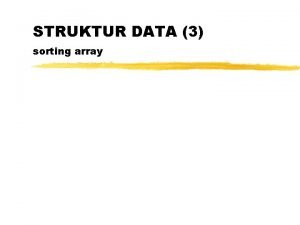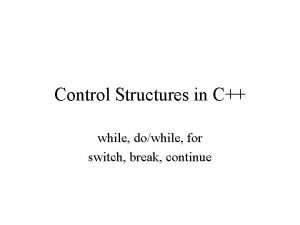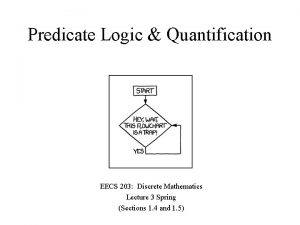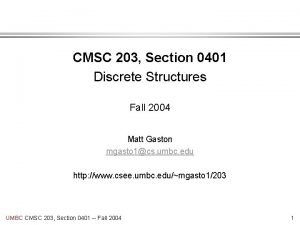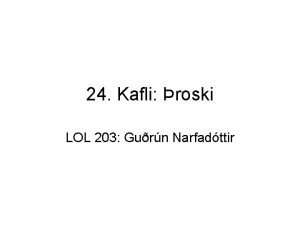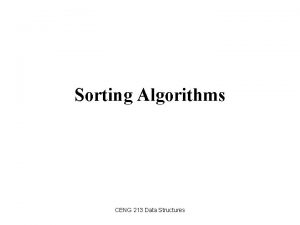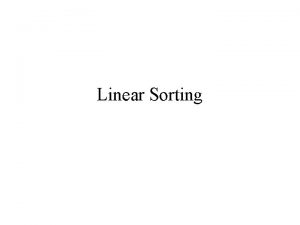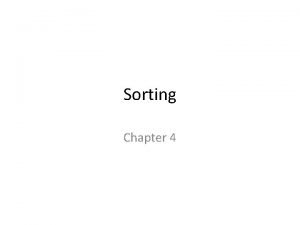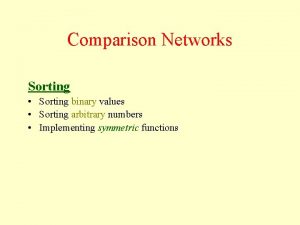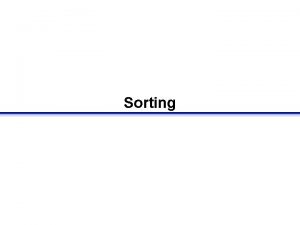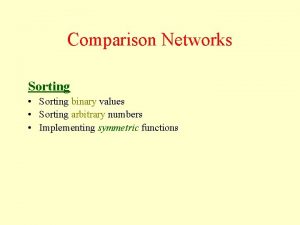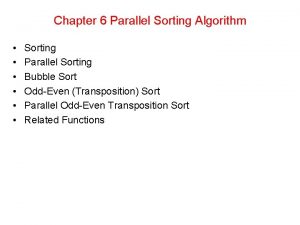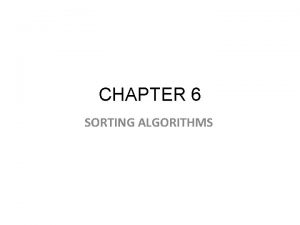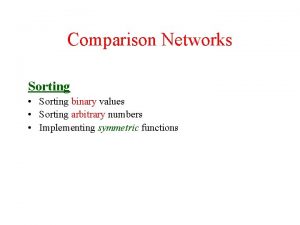CS 203 Programming with Data Structures Sorting Chengyu























![Merge Sort Code … Comparable tmp. Array[]; void merge. Sort( Comparable a[] ) { Merge Sort Code … Comparable tmp. Array[]; void merge. Sort( Comparable a[] ) {](https://slidetodoc.com/presentation_image_h/bdd6fff32333046d5b11af4d91991b93/image-24.jpg)
![… Merge Sort Code void merge. Sort( Comparable a[], int left, int right ) … Merge Sort Code void merge. Sort( Comparable a[], int left, int right )](https://slidetodoc.com/presentation_image_h/bdd6fff32333046d5b11af4d91991b93/image-25.jpg)










- Slides: 35

CS 203 Programming with Data Structures Sorting Chengyu Sun California State University, Los Angeles

Sorting Given an collection of elements, rearrange the elements so that they are in ascending or descending order n n The collection is usually an array The elements are comparable For example: Before sorting: 30 10 15 21 18 25 After sorting: 10 15 18 21 25 30

Bubble Sort Given an array of size N For i=0 to N-1 find the smallest element in the range i+1 to N-1, and swap it with the element at position i Done Or in other words n n n Find the smallest element and put it at 1 st position Find the second smallest element and put it ant 2 nd position …

Bubble Sort Example 0 1 2 3 4 5 30 10 15 21 18 25 After 1 st iteration: 10 30 15 21 18 25 First iteration: • i=0 • The smallest element in the rang 1 to 5 is 10 • Swap 10 and 30

Comparison and Swap Bubble sort n n Number of comparisons? ? Number of swaps? ? Can we improve on Bubble Sort? ?

Decision Tree a<b a, b, c a, c, b c, a, b b<c a, b, c a, c, b b, c, a b, a, c c, a, b c, b, a b<a b, a, c b, c, a c, b, a a<c c<a b<c c<b a, b, c a, c, b c, a, b b, a, c b, c, a c, b, a c<b a, c, b a<c b, a, c c<a b, c, a

Properties of A Decision Tree Number of leaves: ? ? Height of the tree: ? ? Any sorting algorithm that only uses comparisons between elements require at least O(Nlog. N) comparisons

Insertion Sort Make N-1 passes of the array At pass p, n n the first p elements of the array are already sorted. “insert” a[p+1] so the first p+1 elements are sorted.

Insertion Sort Example 1 st Pass: sorted unsorted 30 10 15 21 18 25 Take 10 and insert it into the sorted portion: 10 30 After insertion: sorted 15 21 18 25 unsorted 10 30 15 21 18 25

Insertion Sort Implementation #1: n n n Binary search for insertion position shift elements to the right Insert Complexity of pass P n n log. P comparisons P/2 assignments

Insertion Sort Implementation #2: n Pair-wise swap Complexity of pass P n n P/2 comparisons P/2 swaps

Insertion Sort Complexity Best case: ? ? Worst case: ? ? Average case: O(N 2)

Heap Sort Heap sort strategy n n Construct a heap with N insertions: O(? ? ) Construct a sorted array with N remove. Min: O(? ? ) Can we construct the heap more efficiently (in linear time)? ? Can we perform heap sort without the extra space requirement? ?

Percolate Down 31 14 24 65 16 21 26 32 19 68

Percolate Down 14 31 24 65 16 21 26 32 19 68

Percolate Down 14 21 24 65 16 31 26 32 19 68

percolate. Down void percolate. Down( int pos ) { int child; Comparable tmp = array[pos]; while( pos*2 <= size ) { child = pos * 2; if( child != size && array[child+1]. compare. To(array[child]) < 0 ) child++; if( array[child]. compare. To(tmp) < 0 ) array[pos] = array[child]; else break; } } pos = child; array[pos] = tmp;

Building A Heap Percolate down the non-leaf nodes in 30 10 15 21 18 25 reverse order 30 10 21 15 18 25

Heap Building Example 30 30 10 21 15 18 25 10 21 15 18 10 30 18 21 15 30 25 25 10 21 15 18 25

Heap Building Complexity The complexity of percolate down one node is: ? ? The complexity of percolate down all non-leaf nodes is: O(N)

Heap Sort Algorithm Build a Max. Heap remove. Max() then put the removed value into the last position

Merge Sort Merging two sorted arrays takes linear time 10 15 30 18 21 25 10 15 18 21 25 30

Merge Sort Example 10 15 30 18 21 12 24 11 10 15 18 30 12 21 11 24 10 11 12 15 18 21 24 30
![Merge Sort Code Comparable tmp Array void merge Sort Comparable a Merge Sort Code … Comparable tmp. Array[]; void merge. Sort( Comparable a[] ) {](https://slidetodoc.com/presentation_image_h/bdd6fff32333046d5b11af4d91991b93/image-24.jpg)
Merge Sort Code … Comparable tmp. Array[]; void merge. Sort( Comparable a[] ) { tmp. Array = new Comparable[a. length]; merge. Sort( a, 0, a. length-1 ); }
![Merge Sort Code void merge Sort Comparable a int left int right … Merge Sort Code void merge. Sort( Comparable a[], int left, int right )](https://slidetodoc.com/presentation_image_h/bdd6fff32333046d5b11af4d91991b93/image-25.jpg)
… Merge Sort Code void merge. Sort( Comparable a[], int left, int right ) { if( left < right ) { int mid = (left+right) / 2; merge. Sort( a, left, mid ); merge. Sort( a, mid+1, right ); merge( a, left, mid, right ); } }

About Merge Sort Complexity n n T(1) = 1 T(N) = 2 T(N/2) + N O(Nlog. N) Rarely used in practice n n Require extra space for the temporary array Copying to and from the temporary array is costly

Quick Sort Fastest sorting algorithm in practice Complexity n n Average case: O(Nlog. N) Worst case: O(N 2) Easy to understand, very hard to code correctly

Quick Sort Algorithm Given array A 1. If |A|=1 or 0, return 2. Pick any element v in A. v is called the pivot. 3. Partition A-{v} (the remaining elements in A) into two disjoint groups A 1 and A 2 n n A 1 = {x A-{v} | x v} A 2 = {x A-{v} | x v} 4. Return {quicksort(A 1), v, quicksort(A 2)}

Understand The Notations A: 30 10 15 21 18 25 v: 25 A 1: 10 15 21 18 A 2: 30

Observations About The Quick Sort Algorithm It should work It’s not very clearly defined n n n How do we pick the pivot? How do we do the partitioning? How do we handle duplicate values? Why is it more efficient than Merge Sort?

Picking the Pivot Ideally, the pivot should leads to two equal-sized partitions n n n First element? ? Random pick? ? Median of (first, middle, last)

Partitioning … A: 30 15 21 18 25 10 Pivot = median(30, 21, 10) = 21 1. Swap pivot to the last position 30 15 10 18 25 21 i j

… Partitioning We want to move smaller elements to the left part of the array and larger elements to the right part, So: 2. Increase i until a[i] > pivot Decrease j until a[j] < pivot swap a[i] and a[j] 3. Repeat 2 until i > j 4. Swap a[i] and pivot

More Details Handing duplicates Small arrays n n N>10: quick sort N 10: insertion sort

Exercise Implement quick. Sort
 Internal and external sort
Internal and external sort Hdfi
Hdfi Chengyu sun
Chengyu sun Chengyu sun
Chengyu sun Chengyu sun
Chengyu sun Homologous structures examples
Homologous structures examples Berikut ini beberapa tujuan dari sorting
Berikut ini beberapa tujuan dari sorting Orale charakterstruktur
Orale charakterstruktur Tessy badriyah
Tessy badriyah Program pengurutan sorting dan pencarian searching data
Program pengurutan sorting dan pencarian searching data Pengertian exchange sort
Pengertian exchange sort C++ control structures
C++ control structures Perbedaan linear programming dan integer programming
Perbedaan linear programming dan integer programming Greedy vs dynamic programming
Greedy vs dynamic programming Definition of system programming
Definition of system programming Linear vs integer programming
Linear vs integer programming Definisi linear
Definisi linear Nactrc
Nactrc Eecs 203
Eecs 203 Fha 203(h)
Fha 203(h) Etx-203am
Etx-203am Rad etx-203ax configuration guide
Rad etx-203ax configuration guide Afi 10-203
Afi 10-203 Cmsc 203 umbc
Cmsc 203 umbc 258×203
258×203 Etheraccess
Etheraccess Embeded systems design
Embeded systems design Eet 203
Eet 203 Eet 203
Eet 203 Eecs 203
Eecs 203 Lol-203 b
Lol-203 b Master 203
Master 203 1948 peugeot 203
1948 peugeot 203 951 hangi yüzlüğe yuvarlanır
951 hangi yüzlüğe yuvarlanır 203 fourgonnette
203 fourgonnette Lol203
Lol203










